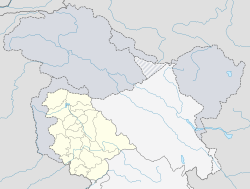Baramulla
|
Baramulla بارہ مولہ Varamulla |
|
|---|---|
| City | |
| Location in Jammu and Kashmir, India | |
| Coordinates: 34°11′53″N 74°21′50″E / 34.198°N 74.364°ECoordinates: 34°11′53″N 74°21′50″E / 34.198°N 74.364°E | |
| Country |
|
| State | Jammu and Kashmir |
| District | Baramulla |
| Population (2011) | |
| • Total | 167,986 |
| • Rank | 4th. |
| Languages | |
| • Official | Urdu |
| Time zone | IST (UTC+5:30) |
| PIN | 193101 (New City), 193102 (Old City), 193103 (Khawajabagh area) |
| Telephone code | 01952 |
| Vehicle registration | JK 05 |
| Sex ratio | 873 ♂/♀ |
| Literacy | 66.93% |
| Website | www |
Baramulla (ˌbærəˈmʊlə) (Urdu; بارہ مولہ Kashmiri; وُرمول, Punjabi, Pahadi) is a city and a municipality in the Baramulla district in the Indian Administered Jammu and Kashmir. It is on the bank of the Jhelum River downstream from Srinagar, the state capital. The city was earlier known as Varahamula which is Sanskrit for "boar's molar".
The name Baramulla is derived from the Sanskrit Varahamula (वराहमूल), a combination of varaha (boar) and mul (root or deep) meaning "boar's molar."
According to Hindu teachings, the Kashmir Valley was once a lake known as Satisaras (Parvati's Lake in Sanskrit). Ancient Hindu texts relate that the lake was occupied by the demon Jalodbhava (meaning "originated from water") until Lord Vishnu assumed the form of a boar and struck the mountain at Varahamula. This created an opening for the water to flow out of the lake.
The modern Baramulla was called Varahamulaksetra or Varahaksetra in the ancient days. Originally, it was a suburb of Huviskapura (modern Ushkur). Associated with the Adivaraha, the boar incarnation of Visnu, it was considered very sacred. Consequently many temples and monasteries weren built in the 9th and 10th centuries, during the region of Lalitaditya Muktapida, (Queen) Sugandha, and Ksemagupta, when the cult of Visnu flourished there.
...
Wikipedia


